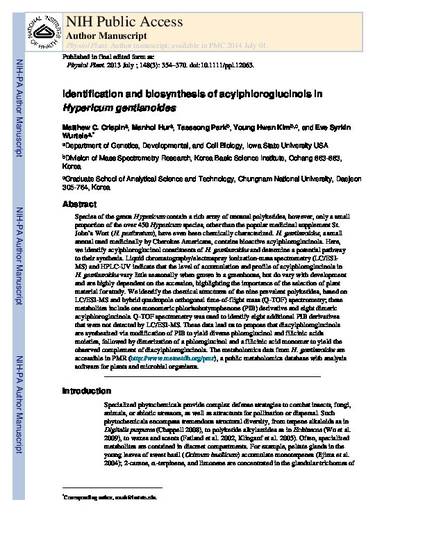
Species of the genus Hypericum contain a rich array of unusual polyketides, however, only a small proportion of the over 450 Hypericum species, other than the popular medicinal supplement St. John’s Wort (H. perforatum), have even been chemically characterized. H. gentianoides, a small annual used medicinally by Cherokee Americans, contains bioactive acylphloroglucinols. Here, we identify acylphloroglucinol constituents of H. gentianoides and determine a potential pathway to their synthesis. Liquid chromatography/electrospray ionization-mass spectrometry (LC/ESIMS) and HPLC-UV indicate that the level of accumulation and profile of acylphloroglucinols in H. gentianoides vary little seasonally when grown in a greenhouse, but do vary with development and are highly dependent on the accession, highlighting the importance of the selection of plant material for study. We identify the chemical structures of the nine prevalent polyketides, based on LC/ESI-MS and hybrid quadrupole orthogonal time-of-flight mass (Q-TOF) spectrometry; these metabolites include one monomeric phlorisobutyrophenone (PIB) derivative and eight dimeric acylphloroglucinols. Q-TOF spectrometry was used to identify eight additional PIB derivatives that were not detected by LC/ESI-MS. These data lead us to propose that diacylphloroglucinols are synthesized via modification of PIB to yield diverse phloroglucinol and filicinic acids moieties, followed by dimerization of a phloroglucinol and a filicinic acid monomer to yield the observed complement of diacylphloroglucinols. The metabolomics data from H. gentianoides are accessible in PMR (http://www.metnetdb.org/pmr), a public metabolomics database with analysis software for plants and microbial organisms.
Available at: http://works.bepress.com/eve-wurtele/44/

This is the peer reviewed version of the following article: Crispin, M. C., Hur, M., Park, T., Kim, Y. H. and Wurtele, E. S. (2013), Identification and biosynthesis of acylphloroglucinols in Hypericum gentianoides. Physiol Plantarum, 148: 354–370, which has been published in final form at doi: 10.1111/ppl.12063. This article may be used for non-commercial purposes in accordance With Wiley Terms and Conditions for self-archiving